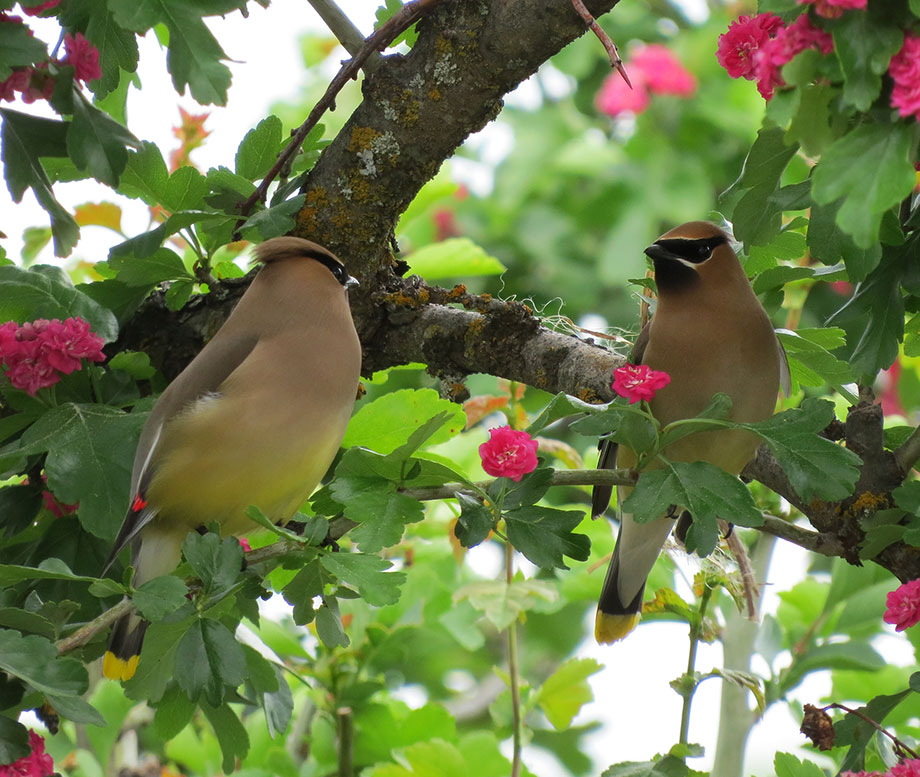July 10 Column: Bird Identification

Bill and I are avid birdwatchers. We’ve created a landscape that attracts them and makes them feel safe. We love listening to them, admiring how beautiful they are, and watching them raise their young. For the most part, we recognize the birds that come here but sometimes we need a little help with bird identification.
For this week’s column, I have written about the things we’ve done to attract birds and also about a new bird identification app that is fantastic. It’s the Merlin Bird ID app from the Cornell Lab of Ornithology. It is free and very easy to use. You can read my column in today’s edition of The Spokesman-Review: Technology can play a hand in identifying birds and their songs. Or you can read my column underneath the video below.
In my video, I officially announce my newest book, The Vegetable Garden Problem Solver Handbook. And not only that, I show you exactly what is in the book. There are so many challenges that can come our way so I decided to create a guide to help you identify and resolve (or prevent) them. It covers what you need to know in order to keep your vegetable plants healthy and productive, how to prevent non-disease-related disorders (i.e., blossom-end rot), vegetable plant diseases, and critters in the garden.
Don’t miss the end of my video! Amazon is currently taking pre-orders for my new book. Everyone who pre-orders a copy will be eligible for my bonus content, “12 Vegetable Crops You Should Add to Your Garden!” All you have to do is forward your order confirmation to me and I will send you the link to the bonus material. This applies for all pre-orders prior to the release of my book in February 2023.
Here’s my garden column about bird identification:
Our garden is filled with birdsong every single day. When we moved into our home over 30 years ago, Bill and I set out to create a landscape that would be appealing to birds because we’re both avid birdwatchers and know they play an important role in the environment.
The first thing we did was to plant a mix of coniferous and deciduous trees as a way to enclose our wide-open piece of property. Many songbirds feel more at ease if they aren’t out in the open.
Next, we added native trees and shrubs to give birds a place to hide from predators, shelter from the weather or build a nest. Some of the shrubs, such as snowberries and American cranberry bush, produce berries that they enjoy eating. Bird feeders filled with black-oil sunflower seeds and suet cakes provide additional nourishment. Our ponds and birdbaths provide them with water for drinking and bathing.
The result has been well worth the effort because we get to watch birds feeding, drinking, going through courtship rituals and raising their young. Just a sampling of our resident bird friends includes hummingbirds, catbirds, cedar and Bohemian waxwings, crossbills, nuthatches, chickadees, hairy and downy woodpeckers, towhees and Northern flickers.
Occasionally, we’ll spot a new visitor that we want to identify or hear a bird call and be curious to know which species it came from. While there are some wonderful bird guides that will help with this, our new favorite tool is the Merlin Bird ID app from the Cornell Lab of Ornithology.
Bill and I recently read an article about this free phone app and quickly loaded it onto our phones. The app contains three different programs that allow you to identify a bird.
The Bird ID Wizard asks three questions about a bird’s size, its coloration and what it was doing when you spotted it, then lists the possibilities. Sound ID provides the option of recording a bird’s call and suggests which bird is singing, all in real time. With Photo ID, you can take a photo of the mystery bird and receive a short list of potential matches.
The first time I used Sound ID, I was astounded at the number of different calls the app identified. One day, while I recorded a 30-second audio clip, it correctly listed a pygmy nuthatch, black-capped chickadee, song sparrow, house finch, red crossbill and American robin as the sources of different songs. Each time one of those birds sang, the app highlighted the name in the list to make it easy to associate the song with the correct bird.
The other cool aspect of Sound ID is that those recordings also visually display as a spectrogram of each bird’s call. It is pretty fascinating technology. To learn more about the Merlin Bird ID app, go to merlin.allaboutbirds.org.
In addition to this app, the Cornell Lab’s All About Birds website (allaboutbirds.org) is a fantastic resource. Visitors can type in the name of the bird they want to know more about and discover its range, the type of habitat it frequents, what they eat, where they nest, information about their behavior, how to attract them to your garden, watch videos of the bird and listen to their calls.
It is so enjoyable to attract birds to your garden and even more rewarding when you have a better understanding of the birds living in and around it.Susan Mulvihill is author of “The Vegetable Garden Problem Solver Handbook” and “The Vegetable Garden Pest Handbook.” She can be reached at Susan@SusansintheGarden.com. Watch this week’s video at youtube.com/susansinthegarden.

